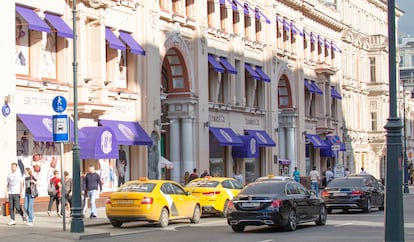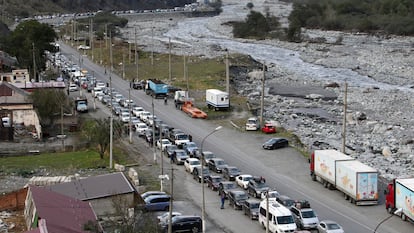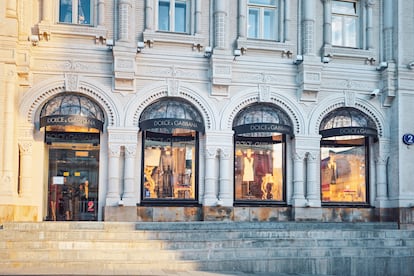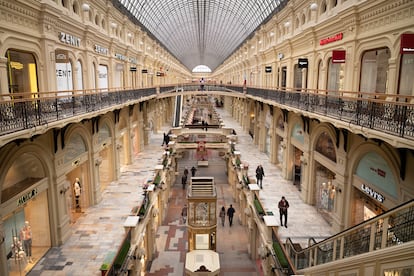Forbidden luxury enters Russia from the south
The constant flow of high-end cars, jewelry, and watches shows the limits of Western sanctions over the invasion of Ukraine. Parallel imports of cell phones and clothing are also on the rise

It is not just oil, airplanes or dual-use (civilian and military) products. The successive packages of sanctions against Russia approved by the EU, the United States, and the United Kingdom also contained — and contain — important restrictions on the sale of luxury Western products, so much to the taste of the Russian elites: high-end cars, watches, and jewelry. Products that should not have been entering the Eurasian giant since the beginning of the invasion of Ukraine. That is the theory; the reality, however, runs along other paths: almost three years later, the wealthiest still lack nothing.
The Hermès and LVMH stores in Moscow were among the first to close their doors, shortly after the start of the war and ahead of mass consumption. Shortly afterwards, the Maybach and Rolls-Royce dealers followed suit, leaving a minority — 55% of Russian workers earn less than $600 a month and nine out of 10 less than $1,000 — without any way of accessing their whims. For a short time.
Under the table, the flow of high-end products from neighboring countries has been a constant since then. The latest international customs data point in this direction, where a strong growth — practically vertical — of imports from countries such as Georgia or Kazakhstan is perceived: increases that the consumption dynamics of these countries cannot explain and an important indication of their participation in a triangulation that is enabling the arrival of these select products to Russia, their true final destination.
“There is strong circumstantial evidence that Western goods are reaching Russia via the Caucasus and Central Asia. This is reflected in the mirror trade data of the EU and other countries,” notes Benjamin Hilgenstock, a specialist at the German Council on Foreign Relations. “The producers of these goods are not adequately monitoring their distribution networks, nor do they have sufficient incentives to do so,” he replied by email. “Western governments,” wrote Robin Brooks, a researcher at the Brookings Institution, “know what is happening: cracking down [on re-exports] is just a matter of political will.”
The EU has banned the export of jewelry and cars worth more than €50,000 to Russia for almost two years. However, alternatives to get them to their destination emerged almost immediately. The first was Turkey, also as a transit country. A route that soon gave way to Belarus, with a government clearly aligned to Moscow. Last summer, the EU tried to close this gap with a new package of sanctions to prevent the obvious evasion by Minsk. It remains to be seen how successful this will be.
Today, however, the biggest hole is in the south: in Georgia, Azerbaijan and Kazakhstan. A recent journalistic investigation by the Georgian portal iFact did not hesitate to describe the border with Russia as a “paradise for vehicle traffic,” with Porsches and Lamborghinis proliferating in the imposing mountains of the Caucasus, the natural border between the two countries.

It is a well-oiled machine. The Russian buyer places his trust in a carrier, a key player in the process, who registers the vehicle in his name outside Georgia and takes out insurance. Once through the Lars Pass — the only crossing from Georgia and the one on which the iFact investigation focused — it is handed over to his Russian counterpart. Then back to Georgia and square one.
That car will have to travel another 1,800 kilometres (1,118 miles) to Moscow, or 2,500 (1,553 miles) to St. Petersburg, the cities where almost all of Russia’s wealthy live. Along the way, there is a stream of roubles, laris (the official currency in Georgia), euros and dollars for middlemen, transporters, and other actors involved in a highly lucrative transfer. A gray market, in short, with many winners and one clear loser: Ukraine.
More than 100,000 Russians have settled in Georgia, fleeing mobilization, not necessarily out of opposition to Vladimir Putin’s government, but simply out of fear of being sent to the front in Ukraine. “Russians have opened more businesses in Georgia in the past two years than in the entire previous 30 years,” complains one member of the Georgian opposition. And some of these companies are key to this trade, says the iFact investigation.
Officially, there is no vehicle trade between Georgia and Russia. Although the Tbilisi government has not established bilateral sanctions against Moscow, last year it explicitly banned the re-export of vehicles to its neighboring country: “We do not want Georgia to be used to circumvent sanctions against Russia,” Nikoloz Samkharadze, head of the parliamentary foreign affairs committee, told EL PAÍS. Samkharadze’s party, which has been in government since 2012, has been accused of increasingly aligning itself with Moscow. Asked about vehicle traffic at the Lars Pass, the politician replied:
― Those cars are Armenian.
― But everyone knows that they are not actually Armenian vehicles.
― Well, the car arrives at customs and has official Armenian papers. We cannot stop anyone traveling from Armenia to Russia.
This trade is therefore not recorded in official statistics. But data from the National Statistics Office do show a significant increase in vehicle exports from Georgia, a country that does not manufacture cars. While between 2012 and 2021, the Caucasian country exported an average of 50,000 cars per year, in 2022 it exported almost 80,000, and last year 108,000. As for profits, they have skyrocketed: if this re-export market previously brought Georgia about €400 million ($432.7 million) per year, it now exceeds €2 billion ($2.16 billion), which indicates that the price per vehicle unit has also increased significantly.
Almost all of these exports go to Armenia, Azerbaijan, Kazakhstan, or Kyrgyzstan, countries heavily involved in trade with Russia in banned Western goods. The Georgian government knows this. “These cars are now being exported from Georgia to Central Asian countries. And then these countries export them to Russia,” says Samkharadze with a shrug. “That is, it is not our fault.”

Smuggling premium products
Smuggling accounts for only 8% of imported vehicles, according to a study by the Otkrytiye bank and the Avtomarketolog channel, but it is dominated by the premium range. You only have to look at the prices on the sales portals to see that a low- or mid-range car is not worth the money. The most popular models are European luxury cars and high-end Chinese models such as the Lixiang and Zeekr.
There are basically two options for acquiring a smuggled car. The easiest is to go to dealers, who have the financial muscle to import large batches of vehicles. If, on the other hand, you want a specific model, the most effective option is to turn to middlemen with contacts in Europe.
“The scheme is simple: someone helps buy and transport the car to the border, someone registers it at customs, someone drives it, and someone participates in the registration,” explains Avto.ru, a website for buying and selling imported cars. However, according to another broker, Avtorevizorro, direct imports from Europe via Belarus have become more complicated since the middle of this year. The reason? Polish and Lithuanian authorities now require many more documents and “sometimes hold vehicles for days.”
Phones and sweaters
A group of Russian tourists from other regions take a photo next to the central fountain in the historic Gum shopping center, which is located next to the iconic Red Square in Moscow. Above them, on the second floor, is the Lacoste store, where the labels show the extra cost of evading sanctions: a cotton jumper that costs $170 sells for 20,000 roubles in Russia, $32 to $43 more. Official stores of Western brands such as Karl Lagerfeld, Hugo Boss, Dolce & Gabbana and Dior, to name a few, also continue to operate in Gum.
Parallel imports have skyrocketed in recent times. And this means, for example, that cell phones cost considerably more than in the rest of the world. In Gum, Samsung sells the 256-gigabyte Galaxy Z for 189,990 roubles, around $1,940. That is $755 more than in Spain, for example. “The official service will repair your phone here, in our almost 300 centers in Russia and also overseas. And if you bring another phone, we will give you a discount on the purchase of the new one,” one of its salesmen insists.
Products from brands that have completely abandoned Russia are still around. Apple’s new iPhone 16 went on sale here days before its official launch, even though the American tech giant has shut down its business in the country. “We guarantee repairs in our own centers, but the phone doesn’t have an official Apple guarantee. You know, parallel imports,” says, sparingly, the salesman at Re:Store, a Russian chain that now occupies the place where the Californian firm once stood.

Re:Store is less timid on its official website: “Many companies will resort to parallel imports of foreign products in the near future,” the Russian firm predicts. Although the Constitutional Court banned smuggling in 2018, at the start of the war the Kremlin legalized it to circumvent sanctions.
“Parallel import does not in any way legalize counterfeit products, we are only talking about the delivery of original products. If retailers try to introduce counterfeits into the country, this will be considered a serious violation of the law,” Re:Store writes, along with a sketch justifying a hack that follows a very simple scheme: the factory sells the phone to a third country and re-exports it to Russia.
Doubts about the effectiveness of sanctions
Luxury goods form just a part of the list of Russian bypasses of G-7 sanctions. Far from the economic apocalypse that many anticipated in the early stages of the invasion, Russia’s GDP has survived the situation better than expected: after falling 1.2% in 2022, it rebounded 3.6% last year and is on track to record similar growth this year, according to the latest projection from the International Monetary Fund (IMF). Fueled, of course, by runaway military spending, which overshadows the damage to other vital constants. “The increase in demand from the military industry has sustained the economy,” Maxim Mironov, a professor at the IE Business School and author of several studies on sanctions, tells EL PAÍS by phone. “But GDP no longer represents the economic reality of the country: the consumption capacity of families has fallen, and a lot.”
The sanctions, Mironov continues, “have had an economic impact, but not enough to stop the war. There are far fewer Western products in Russia and their price has skyrocketed, so the biggest losers have been the people, the families. Poverty has increased, but Putin’s spending capacity on the war has remained the same.” His conclusion is clear: “The restrictions are not enough and, above all, they have to be better-designed.” The EU is in the process of reviewing its economic reprisals against Russia in order to plug the loopholes that still exist, especially those that allow the arrival of critical materials for the Kremlin through China. Another can of worms to be cracked.
Sign up for our weekly newsletter to get more English-language news coverage from EL PAÍS USA Edition
Tu suscripción se está usando en otro dispositivo
¿Quieres añadir otro usuario a tu suscripción?
Si continúas leyendo en este dispositivo, no se podrá leer en el otro.
FlechaTu suscripción se está usando en otro dispositivo y solo puedes acceder a EL PAÍS desde un dispositivo a la vez.
Si quieres compartir tu cuenta, cambia tu suscripción a la modalidad Premium, así podrás añadir otro usuario. Cada uno accederá con su propia cuenta de email, lo que os permitirá personalizar vuestra experiencia en EL PAÍS.
¿Tienes una suscripción de empresa? Accede aquí para contratar más cuentas.
En el caso de no saber quién está usando tu cuenta, te recomendamos cambiar tu contraseña aquí.
Si decides continuar compartiendo tu cuenta, este mensaje se mostrará en tu dispositivo y en el de la otra persona que está usando tu cuenta de forma indefinida, afectando a tu experiencia de lectura. Puedes consultar aquí los términos y condiciones de la suscripción digital.
More information
Archived In
Últimas noticias
Maduro pleads not guilty before the federal court in New York: ‘I am still the president of Venezuela’
A new test can detect Alzheimer’s from a finger prick
UN team enters Sudanese city of El Fasher after paramilitary massacre: ‘It’s like a ghost town’
A recipe for resistance: Indigenous peoples politicize their struggles from the kitchen
Most viewed
- Gilles Lipovetsky: ‘If you want to live better and fall in love, take Prozac, don’t look to philosophy’
- Alain Aspect, Nobel laureate in physics: ‘Einstein was so smart that he would have had to recognize quantum entanglement’
- Alvin Hellerstein, a 92-year-old judge appointed by Bill Clinton, to preside over Maduro’s trial in New York
- Maduro’s downfall puts China’s relationship with Venezuela to the test
- Why oil has been at the center of Venezuela-US conflicts for decades









































